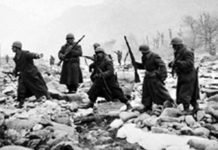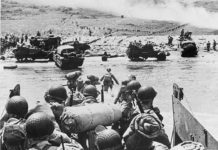The ability of the Roman Empire to conquer vast territories was grounded in the might and innovation of their military forces.
The implementation of various tactics in battle harnessed the strength of the Roman Army, particularly the infantry forces.
Sextus Julius Frontinus
The works of Sextus Julius Frontinus emphasised the importance of the choice of the battle ground and the orientation of the army formation. Having height over the enemy is advantageous, as is having rougher ground if infantry is faced with enemy cavalry. Furthermore, Frontinus indicated the army should be positioned such that the sun is behind them, dazzling the enemy. Strong wind should also be blowing away from the army, providing an advantage to your missiles and blinding the enemy with dust.
Tortoise
A defensive formation in which legionaries in the front rows would hold their shields in front while those behind would position them overhead, the tortoise created a shell-like armour shielding legionaries against enemy missiles from above or the front. Although this formation was slow moving, it was very effective during sieges and/or when facing enemy archers because it was almost impenetrable to enemy fire. However, the tortoise was a weak formation in hand to hand fighting, and so was only employed when legionaries were far enough away to switch to another formation before getting attacked.
Wedge
The wedge was an attacking formation in which legionaries would form a triangular shape with the front ‘tip’ being a single man facing the enemy. This allowed small groups to be thrust, or ‘wedged’, deep into enemy lines. Enemy troops were pushed into restrictive positions when the wedge formation expanded, making hand to hand fighting difficult. The gladius could be used as a thrusting weapon, which was more useful than the longer swords which became impossible to wield in such a formation.
Saw
The saw, a defensive tactic against the wedge, was a detached unit immediately behind the front time. Capable of swift sideways movement down the length of the line, the saw was able to plug holes in the front line and develop a thrust where signs of weakness were evident.
Skirmishing Formation
As opposed to the tightly packed battle ranks so typical legionary tactics, the skirmishing formation made use of a widely spaced line up of troops, allowing for greater mobility.
Repel Cavalry
To repel approaching enemy cavalry, the first line would form a wall with their shields with only their pila protruding. A second rank of infantry would use spears to drive off any attackers whose horses halted before the barrier.
Orb
This defensive position in a circular shape was adopted by a unit in desperate times. It allowed for reasonably effective defence even if parts of the army had been divided in battle. This formation would have required a high level of discipline from individual soldiers.
Rotation
To prevent soldiers becoming over exhausted during fierce battles, soldiers would only be at the front of a fighting column for 15 minutes before being moved to the back.
Starving a Siege Town into Submission
The Romans often forced siege towns into submission by starving them. After surrounding the town with artillery, the army would wait for the towns’ supplies to run out. If this took too long, siege towers were built, allowing soldiers to easily scale walls of a town.
The Triple Acies Battle Formation
Roman legions developed techniques and formations to stop all the confusion in battle. The usual battle formation they adopted was the triple acies, which included three parts: acies prima – the first and strongest line of defence which consisted of 4 cohorts; acies secunda – three cohorts, often of mediocre soldiers, whose purpose in battle was to fill holes in the first line whenever gaps formed; acies tertia – a weak set of 3 cohorts used to protect against flanking and in case second line needed extra men to help fill in the first line.
Signals Used in Battles
The Roman military used various signals for communication during battle. These included the cornu – a horn with a deep loud sound blown to signal for basic formations, as well as the tuba – which looks like a trumpet and gave precise battle commands. Other battle signals were the bucina which told soldiers when lunch breaks were happening and signalled preliminary formations, and the lituus which was used to signal the cavalry.








